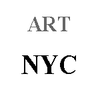

Future fair is unfamiliar. Launched in 2020, but couldn't turn it off due to Covid, then resumed exhibition from last year and has long been at Chelsea Industries. Everyone will promote it in their way, but there will be many people who don't even know there is such an art fair. Since it is a new fair that has just started, I think the exhibition participants will have to make more efforts to promote it to achieve good results.
This exhibition is a week before the Freeze Art Fair. The ticket price is considered high compared to its size and reputation. Therefore, you may hesitate to go there if you are not interested in art. But the curating of the exhibition was unexpectedly good. It seems to have put a lot of effort into booth design and selection of works. And as the name suggests, it is Future Fair, so we selected the new writers who will be popular soon. Galleries in the Brooklyn area or galleries from other countries to introduce contemporary artists were noticeable. The works were all original, and unlike other art fairs that introduced new artists, booths that gave a crude feeling were not apparent. There have also been progresses that stands out in terms of diversity.
SUPPAN. ART from Austria presented works by Karo Kuchar Australian, b. 1986, European pastel colors and soft materials were attractive to express daily life, and the experimental pieces made of the chicken skin of Sabrina Haertig Gonzalez from Brooklyn stood out. The fact that he prepared a simple catalog to promote himself was also memorable because it seemed to show the sincere knowledge expected from new artists.
<To the Artists And to the gallerists who introduce up-and-coming writers>
What artists or gallerists should never leave out of the exhibition of emerging artists is a simple catalog or paper that allows them to know these author introductions or previous works. These days, people ask you to take QR codes to look cool or under the pretext of thinking about the environment, but the audience is not interested in your works to the extent that you take them on the spot. It's unfamiliar because it's my first time seeing all of them. And your competitors are all gathered in one place. Collectors have a lot of work to do with cell phones. I have to take pictures, search, and make calls. If you're overseas, you have to search for the exchange rate. Therefore, batteries should be saved. The QR code scan disappears when you take the following QR code.
On the other hand, a classic paper introduction to the writer gives you a brief glimpse of the writer. Usually, collectors take a break from a cafe or champagne bar at an art fair, take the paper they received, and organize it. After reading the article, it is natural to know more about the writer and revisit the memorable artist's booth. Visual charm will come first when purchasing a work when seeing an exhibition of a new artist. Still, the artist's story and sincerity open the collector's wallet, especially when market conditions are not good. If market conditions are good, works worth millions of won will be sold out as early as possible. However, this cycle returns once every 10 or 20 years. Up-and-coming artists and gallerists who participate in the art fair should never ignore the value of the information on a piece of paper. You are neither Picasso nor Frank Stella. It is a necessity, not a choice, to inform hard. It would be nice to show sincerity in preparing at least one A4 paper. I bet this increases the likelihood of selling works more than ten times.
I know you are busy and in a hurry at the art fair, but impatience is something to be wary of. Art fairs cost a lot of money, so you can be anxious if there are not many visitors or if sales are not good. But collectors feel all this energy. In particular, there are cases where you forget the essential explanation of the work and the artist because you want to sell it so much that you only explain the shell of the work. For example, installation artists sometimes publish photo book editions for collection. Still, they do not talk about the artist's installation work but talk about the quality of the materials in the edition. An artwork is not a product. Let's not forget that collectors pay for the value of art, not just because the material is high quality.
The quality of the exhibition planning was unexpectedly good at this Future Fair, but I think we need to make more efforts in terms of sales and promotion. The results will be better if you have a strategy to invite more collectors with purchasing power than ticket sales.

